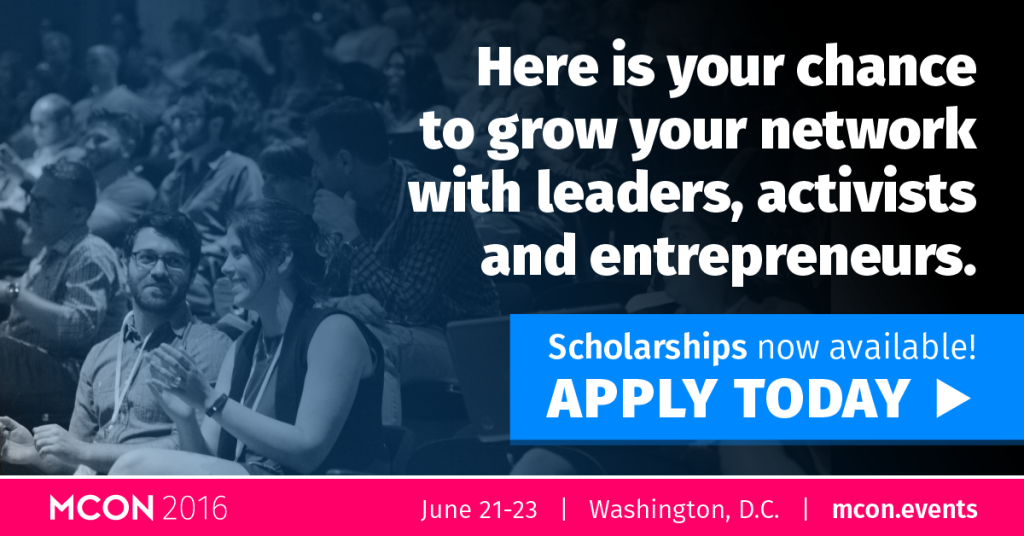The following was originally posted on Achieve’s blog to share my experience as an MCON 2015 scholarship recipient. Applications are now open to attend MCON 2016. APPLY NOW
What is better than attending the premier millennial engagement conference of 2016? Attending it for free.
In April of last year, I read an article from Achieve President Derrick Feldmann about activating the millennial generation (born 1980-2000). At the time, bringing my generation into the fold was something I was very interested in, but had very little idea how to do. Derrick’s article stood out to me in the obvious depth of knowledge about the topic. Perhaps even more exciting, his article mentioned an upcoming conference called MCON devoted to this very topic.
At the time, I was working for a small, but growing nonprofit, so I was incredibly fortunate to receive an MCON scholarship because the conference is designed for people just like me—millennials that want to better understand what drives our generation to give and get involved, but wouldn’t otherwise have the resources to attend. I knew I needed to be in the room with these thought leaders, but I don’t think I was quite prepared for how much I’d learn and take away from the experience.
When I walked into the Chicago Museum of Art last June, I was blown away by the buzz and energy that filled the room. Though I knew that engaging the next generation of cause leaders was important, it was incredible to see so many people in one place who were as excited as I was by the extraordinary potential for global change that the millennial generation holds.
As I checked-in and grabbed my conference badge and (awesome) swag bag, I could already hear nearby conversations of people explaining their different reasons for attending MCON. Some people, like me, were working for nonprofits and were there to learn how to engage millennials in their work. Some were starting social enterprises and wanted to be sure they knew how to best integrate the issues that millennials care about into their products and programs. Others still were from large corporations that wanted to better understand how to attract and retain millennial talent through corporate social responsibility. No matter the specific goals, it was clear that we all shared one thing in common: we cared, A LOT, about social good and changing the world, and we knew engaging millennials in our causes was key.
 At the conference I heard from a wide variety of speakers—from foundations and nonprofits that were using innovative ways to reach millennials, to businesses that were going beyond cause-marketing and integrating a social mission into their long-term business strategy. I learned how the Knight Foundation is investing in public art projects as an urban revitalization technique—helping to deepen the sense of place and connections across demographics in cities—and how millennials, with their propensity to live in proximity to city centers, are key to this work.
At the conference I heard from a wide variety of speakers—from foundations and nonprofits that were using innovative ways to reach millennials, to businesses that were going beyond cause-marketing and integrating a social mission into their long-term business strategy. I learned how the Knight Foundation is investing in public art projects as an urban revitalization technique—helping to deepen the sense of place and connections across demographics in cities—and how millennials, with their propensity to live in proximity to city centers, are key to this work.
Another session that stood out to me focused on how one nonprofit, Baltimore Corps, is utilizing the energy and talents of the next generation to strengthen Baltimore through fellowships aimed at scaling promising solutions to persistent problems.
It wasn’t just the speakers that made me really happy that I attended MCON. Networking with other attendees was invaluable. Discussion groups were a common theme, and many of the people I spoke with were struggling with the same issues that I was.
When I got back to DC, I was able to use what I learned at MCON to develop a millennial engagement strategy for the nonprofit I worked at. I was better equipped to put together programming and communications to reach this vital audience. I was also motivated to join the newly formed Year Up Young Professionals Network, an effort by Year Up National Capital Region to engage millennials in their vital work. Attending MCON has made me a significantly better member of this network, able to provide input and insights from the conference to help shape and strengthen this new initiative. And I was even driven to become more deeply engaged than that, seizing an opportunity to come work for the Case Foundation, the lead sponsor of MCON and the Millennial Impact Report, when a job opening arose.
This year, I am so excited that MCON has come to my own backyard in DC. I often say that one of my favorite things about living in DC is how passionate everyone is about something. You may not always agree with the cause they care about, but just having a city full of people who give a damn is exhilarating. I can think of no better place to host such a vibrant conference, and I hope that you’ll join me at MCON 2016. If you, like me, care deeply about changing the world and growing your network with leaders, activists and entrepreneurs, then don’t miss the chance to be inspired at MCON. Scholarship applications are now open, so what are you waiting for?




